Abstract
The compact city has garnered significant attention from researchers in academia, particularly in recent years, due to its relevance to various global challenges, such as climate change, COVID-19, economic crises, and urbanization. Given the vast knowledge represented in the compact city literature and its diverse perspectives, this study aims is a comprehensive literature review through bibliometric analysis. Following the PRISMA protocol, a total of 570 articles from the Scopus database published in English between 1973 and 2022 underwent screening at two main levels of bibliometric analysis: performance analysis and science mapping. The findings of this study reveal a substantial increase in scientific production related to the compact city over the years. Furthermore, the concept of the compact city encompasses multiple dimensions, with a significant emphasis on the urban dimension. Remarkably, Asian countries (regions), particularly mainland China and China-Hong Kong, demonstrate a notable interest in the compact city concept. In conclusion, this study provides valuable insights into the scientific production of compact city literature, highlighting its growth, multidimensionality, and geographic focus, which can inform future research and policymaking efforts.
1. Introduction
The notion of the compact city has arisen as a prominent paradigm across numerous fields of research, including urban studies, sustainability, environment, transportation and mobility, public health, and public services, among others, for several decades [1,2]. This has led to widespread discourse and deliberation among scholars, policymakers, and academia in general. This broad interest and attention can be attributed not only to the vast and diverse range of disciplines encompassed by the compact city research field but also to the origins and underpinnings of this urban concept, as well as the varying definitions and interpretations that have emerged over time.
Before delving into the various definitions of the compact city, it is important to understand its roots. The term emerged in the 1930s as a response to urban expansion and the need to preserve the environment and agricultural land, though it was not yet fully developed as a concept [3]. In the 1960s, planning reformers introduced different models for dense cities, e.g., Jane Jacobs in her book The Death and Life of Great American Cities [4]. The term “compact city” was coined in 1973 by mathematical scientists George Dantzig and Thomas L. Saaty in their book Compact City: A Plan for a Liveable Urban Environment, which aimed to achieve more efficient resource use [5].
In the 1990s, the compact city concept evolved to include sustainable urban planning and policy goals related to urban sustainability, green growth, and climate change. During this period, there was a shift towards recognizing the importance of compact city principles in achieving long-term environmental and social goals. A notable milestone in this evolution occurred in the early 1990s, specifically in 1990, when the concept of multidimensional policy goals for compact cities gained prominence. These goals aimed to address various aspects of urban development in compact cities, such as land use efficiency, transportation systems, energy consumption, and social equity. Furthermore, in 1992, the United Nations Conference on Environment and Development introduced Agenda 21, which emphasized the need for compact and efficient urban forms to reduce resource consumption, promote environmental stewardship, and enhance resilience to climate change impacts. In 1994, the emphasis shifted towards the environmental and sustainability aspects of the compact city concept. This coincided with the entry into force of the United Nations Framework Convention on Climate Change (UNFCCC), which recognized the potential of compact cities as a strategy to mitigate greenhouse gas emissions. The compact city concept gained recognition for its ability to reduce reliance on private vehicles, promote energy-efficient buildings, and facilitate the utilization of renewable energy sources in urban areas.
In the new millennium, the concept has further evolved to focus on environmental concerns and city creativity and viability [3]. One aspect of this evolution is the heightened attention given to environmental considerations within the compact city framework. For example, initiatives have emerged to enhance waste management systems, encourage sustainable water usage, and protect and restore natural habitats within compact cities. Additionally, compact cities have become increasingly recognized as hotspots for creativity, entrepreneurship, and cultural exchange. Urban revitalization projects, adaptive reuse of historic buildings, and the creation of vibrant public spaces have become key strategies in promoting city creativity in the 2000s. It is noteworthy that the compact city concept has received considerable attention and endorsement from various global organizations, including the European Union, the Organization for Economic Co-operation and Development (OECD), and the United Nations Human Settlements Programme (UN-Habitat), since the 1990s [6,7]. Figure 1 illustrates the detailed evolution of the compact city concept.
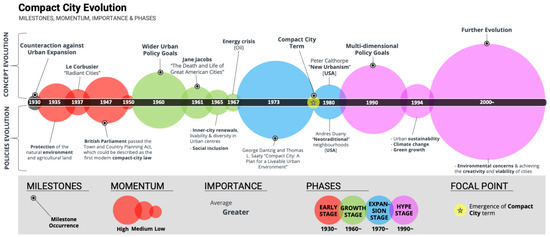
Figure 1.
Evolution map of compact city concept.
Despite the growing popularity of the compact city concept, there is no widely accepted and precise definition of this type of urban form. Rather, the definition of the compact city varies according to the objectives and the approach taken to consider and analyze it [7,8]. However, it is generally agreed that the majority of definitions center on the idea of a high-density city with mixed land uses that promote public transportation, walking, and cycling. For instance, Newman and Kenworthy describe the compact city as a city with “more intensive land use, centralized activities, and higher densities” [9], while Elkin and McLaren describe it as “intensification of the use of space in the city with higher residential densities and centralization” [10]. Breheny’s definition, in turn, emphasizes that “compact cities have high density and mixed-use, with growth encouraged within the existing urban boundaries” [11]. Recently, Daneshpour and Shakibamanesh described a compact city as “a city that mixes shared civic spaces with concentrated arrangements of structures” [12]. Despite their differences, these definitions share a common kernel that portrays the compact city as a high-density, mixed-use urban form that emphasizes sustainability, livability, and efficiency.
This multifaceted nature of the compact city concept has sparked an ongoing debate regarding its merits and drawbacks from various perspectives and dimensions. One such perspective is the urban aspect, which highlights the benefits and potential risks of the compact city concept. From a positive standpoint, compact cities are viewed as a means to mitigate the negative consequences of urban sprawl. For instance, they can help reduce energy consumption by minimizing the distances between residential areas, workplaces, and amenities, thus decreasing the need for long commutes and reliance on private vehicles. Additionally, by promoting mixed-use development and efficient public transportation systems, compact cities contribute to reducing air pollution and traffic congestion, resulting in improved air quality and enhanced mobility options for residents. Another benefit of compact cities is their potential to protect valuable land resources. By prioritizing higher-density development within existing urban areas, compact cities can prevent the conversion of fertile agricultural land into urban sprawl. This preservation of fertile soil is crucial for maintaining local food production and preserving ecosystem services such as water filtration, carbon sequestration, and biodiversity conservation. Compact cities also offer enhanced urban connectivity and access to services. By concentrating residential, commercial, and recreational areas in close proximity, they facilitate ease of movement and provide residents with convenient access to amenities such as schools, health-care facilities, parks, and cultural institutions. [13]. However, it is important to consider the potential risks associated with compact cities. One such risk is overcrowding. As compact cities concentrate a larger population within a limited space, there is a possibility of increased density and population pressure. This can lead to such challenges as increased competition for resources, strain on infrastructure, and potentially social issues related to stress and reduced quality of life [14].
From a social viewpoint, compact cities can promote social interaction and community cohesion, achieving what is now called social equality. They offer more opportunities for people to connect and socialize, which can have a positive impact on mental health and well-being. Nonetheless, compact cities can also result in social exclusion and segregation, especially if affordable housing options are limited.
Additionally, the economic perspective suggests that compact cities can be more cost-effective and efficient than sprawling cities due to the reduction in infrastructure costs and increased productivity through agglomeration economies [15,16]. Furthermore, investors perceive compact cities as innovative and forward-thinking, making them more attractive to investment and investors. However, compact cities may also result in higher living costs, mainly regarding housing. From an environmental point of view, compact cities have the potential to reduce greenhouse gas emissions by promoting sustainable transportation, such as walking, cycling, and public transport [17]. They can also conserve countryside and agricultural land while protecting natural habitats. However, compact cities can also contribute to air pollution and urban heat islands, particularly in areas with high density and limited green space.
From a mobility perspective, compact cities can provide better access to public transport, which can reduce car dependency and traffic congestion. This can lead to improved air quality and reduced carbon emissions [18]. However, compact cities can also lead to overcrowding and long commuting times, particularly if there is insufficient investment in public transport infrastructure [19,20]. Moreover, from a public health perspective, compact cities can promote active lifestyles and reduce the risk of chronic diseases such as obesity and diabetes [21]. They can also provide better access to health-care services. However, compact cities can also contribute to stress and mental health problems, particularly if there is high density and limited green space [22,23]. Additionally, from a political perspective, compact cities can lead to better governance and decision-making. They can promote citizen participation and accountability, particularly if there is strong community engagement. However, compact cities can also lead to social and political tensions, particularly if there is unequal access to services and opportunities [24,25].
In the past few years, the concept of the compact city has gained significant attention, due to two crucial global issues. The first issue is the outbreak of the COVID-19 pandemic in 2020, which caused uncertainty and fear worldwide, with some studies focusing on the impact of urban environments like compact cities on the transmission of communicable diseases [26]. Some studies’ findings have shown that walkable, well-connected, and easily accessible compact cities with green spaces and physical activity opportunities can aid in reducing the spread of COVID-19. Nevertheless, other studies have raised concerns that higher population and dwelling densities in compact cities may increase the spread of COVID-19, as the virus is primarily transmitted by respiratory particles in aerosols and droplets [27,28]. The second issue is climate change, which has become the most pressing issue facing humanity. Compact cities have the potential to play an essential role in mitigating climate change by reducing greenhouse gas (GHG) emissions, promoting the use of sustainable transport options, and encouraging the use of renewable energy sources such as solar and wind power [29]. However, compact cities face several challenges in addressing climate change, such as high-density development that can lead to increased energy consumption and heat island effects, where urban areas are considerably warmer than their surrounding rural areas. Additionally, retrofitting existing buildings in compact cities to make them more energy-efficient poses challenges.
It is important to mention that compact cities are highly relevant to the Sustainable Development Goals (SDGs), which were adopted by the United Nations in 2015 as a blueprint for global sustainable development until 2030. The SDGs aim to end poverty, protect the planet, and ensure prosperity for all. Drawing from the detailed discussion of the different aspects and impacts of compact cities provided earlier, it can be inferred that compact cities have the potential to make significant contributions to several SDGs, specifically, those linked to sustainable cities and communities (Goal 11), climate action (Goal 13), and affordable and clean energy (Goal 7) [30,31].
Finally, this variety of approaches to the concept of compact cities (e.g., definitions, dimensions, measurements, indicators, goals, characteristics, models, policies and strategies), coupled with their relevance to pressing global issues (e.g., COVID-19, climate change, sustainability and SDGs) and the lack of clarity regarding their benefits and drawbacks, has resulted in a significant body of literature and knowledge related to the compact city concept. This serves as one of the main justifications for undertaking this research. Therefore, the primary aim of this literature review is to investigate the extent to which the concept of compact cities has been explored and comprehensively understood in academic literature. The research question of this study is centered on this aim and seeks to identify the level of understanding that has been reached regarding the various dimensions and elements of compact cities.
2. Materials and Methods
This systematic review study followed the PRISMA (Preferred Reporting Items for Systematic Reviews and Meta-Analyses) guidelines to identify pertinent literature on the topic of compact cities (see Supplementary Material). The PRISMA protocol was developed to promote transparency, quality, and comprehensiveness in systematic review studies across academic disciplines [32,33]. To adhere to the PRISMA guidelines, the author established specific criteria for including and excluding articles (see Figure 2 below), enabling the identification of relevant publications pertaining to the compact city field. Subsequently, the study employed bibliometric analysis as a methodology for conducting a literature review of the compact city as a research trajectory within the academic realm. In recent times, bibliometric analysis has gained popularity as one of the most reliable and objective methods of literature review [34]. Despite its roots dating back to the 1890s, the approach has become increasingly fashionable in academia [35]. At its core, bibliometric analysis aims to gather, portray, examine, assess and monitor published academic literature that pertains to a specific research domain [36]. This approach has become the preferred technique for analyzing research output in various domains, including urban studies. By applying this method, this research aims to provide a comprehensive overview of the existing literature on this topic and to identify the major trends, research gaps, and potential avenues for further research. This study methodology will consist of two methodological steps: data collection and bibliometric analysis levels.

Figure 2.
PRISMA flow diagram for the compact city literature selection process. Source: Researcher, based on [33].
2.1. Data Collection
The data for this bibliometric analysis study were collected from the Scopus Core Collection, a comprehensive scientific publication database spanning various disciplines. Scopus was preferred and selected over other alternative databases such as Web of Science (WoS) for several key reasons. Firstly, the objective of this article centers on collecting all possible published articles that discuss the concept of compact cities. This can be accomplished more effectively by selecting a database with broader coverage of journals and records, and Scopus outperforms other alternatives, including WoS, in terms of article and source coverage. Secondly, the methodology employed in this study, bibliometric analysis, relies on gathering extensive bibliographic data for the published articles. Scopus also provides a wider range of metrics for evaluating research impact than other databases [37]. Lastly, many researchers across various scientific fields, including urban studies, have favored Scopus as their primary database of choice when conducting bibliometric analysis studies [38].
To extract relevant articles, a comprehensive search strategy was developed using a combination of keywords and vocabulary. The search terms included variations of “compact cities”, “compact urban”, “mixed land use cities”, “density populated cities” and other related terms. Detailed information regarding the search queries utilized in this study can be found in Table 1. It is worth mentioning that the search strategy was refined through iterative testing to ensure its suitability and effectiveness in capturing the relevant records. For example, the articles considered for analysis were limited to those published in peer-reviewed sources and written in English. The study emphasized the article title as the primary search field to minimize the inclusion of irrelevant records. All articles published in 2023 were excluded to account for the ongoing scientific year. A screening process based on the titles and abstracts of the articles was conducted to exclude any irrelevant publications.

Table 1.
Search query for data collection.
2.2. Bibliometric Analysis Levels
The bibliometric analysis utilized in this study comprises two main levels: performance analysis and science mapping. Each level employs distinct metrics and analytical units to examine different aspects of the research literature addressing the compact city concept within their respective contexts. The performance analysis level included metrics and analytical units such as annual scientific production, sources analysis, author analysis, document analysis, and country (region) and institution analysis. On the other hand, the science mapping level involved keyword analysis, reference analysis, and exploration of literature dimensions and themes. By employing these comprehensive bibliometric analysis levels, this study provides valuable insights into the research landscape focusing on the compact city concept, highlighting key contributors, influential works, emerging trends, and collaborative networks.
Regarding the software employed for bibliometric analysis in this study, although various researchers have used different software tools, such as BibExcel [39], Sci2 [40], Pajek [41], HistCite [42], SciMAT [43], Gephi [44], CitNetExplorer [45], and others for conducting bibliometric studies, this study opted for a combination of R (utilizing the bibliometrix package and biblioshiny), VOSviewer [46], and CiteSpace [47]. The selection of these three software tools was motivated by the aim to mitigate potential limitations associated with individual programs, as each software possesses its own strengths and weaknesses. For instance, certain software excels in statistical bibliographic analysis and generating numerical outcomes for published articles, while others thrive in visualization capabilities, science mapping functionalities, and diverse bibliometric analysis networks. In this study, R, in conjunction with the bibliometrix package and biblioshiny, provided robust features for data preprocessing and performance analysis [48]. Meanwhile, VOSviewer and CiteSpace specialized in scrutinizing citation networks, pinpointing knowledge domains and identifying emerging trends. By employing these software tools in combination, a comprehensive and multidimensional analysis was achieved, aligning with the research objectives and enhancing the validity and reliability of the findings.
3. Results and Discussion
Figure 2 illustrates the PRISMA flow diagram, which outlines the process of selecting relevant studies for bibliometric analysis. The diagram demonstrates the progression from the initial search to the final 570 studies related to compact cities that were suitable for the application of the bibliometric analysis approach.
These 570 documents were published between 1973 and 2022 and originated from diverse sources, including 274 journals or conferences. Additionally, these records exhibited an annual growth rate of 9.09% and an average citation per document of 29.58, indicating an increasing interest in the study of the compact city concept over time. The dataset involved the contributions of 1151 authors, reflecting the collaborative nature of research in this field. Out of these authors, 118 were responsible for single-authored documents, while collaboration was observed in 146 documents, with an average of 2.85 coauthors per document. The dataset also exhibited a rich set of keywords, including 2655 Keywords Plus (ID) and 1396 Author Keywords, indicating the comprehensive coverage and depth of the compact city literature. Figure 3 presents the key information and insights derived from the collected articles. With the dataset and its general information established, the subsequent sections of this article will delve into the various bibliometric analysis levels and analytical units utilized to further explore and understand the research landscape of the compact city concept.

Figure 3.
Summary of compact city literature dataset.
3.1. Performance Analysis
The performance analysis level in bibliometric analysis focuses on understanding the productivity and impact of researchers or institutions in the field of compact cities. It involves evaluating research trends, identifying strengths, exploring collaborations, and informing decision-making processes. In this study, the performance analysis level includes five analytical metrics: annual scientific production, source analysis, author analysis, document analysis, and country (region) and institution analysis.
3.1.1. Annual Scientific Production Analysis
The analysis of annual scientific production in the field of compact city literature reveals notable trends in publication output and citation impact. The data presented in Figure 4 show a gradual increase in publications and citations over the years. During the early years, there was limited activity, with only a handful of articles discussing the compact city concept, resulting in minimal citation counts. For example, from 1973 to the early 1990s, a total of five articles were published, receiving a mere 70 citations. However, from the 1990s onwards, there was a notable rise in both the number of articles published and the corresponding citations received. The published articles in this period received varying numbers of citations, ranging from 84 citations in 1994 to 941 citations in 1997. The year 2000 and onwards witnessed a substantial increase in both the number of publications and citations. Multiple articles were published annually, with the highest number recorded in 2022, with 71 articles. The corresponding number of citations also showed a rising trend, reaching its peak in 2012, with 1625 citations. Overall, these findings indicate a growing interest and recognition of the research conducted within the compact city literature domain. The increasing publication output and citations indicate a rising awareness of the benefits and potential of compact cities in addressing urban sustainability, energy efficiency, transportation planning, and other related topics. Figure 4 provides a comprehensive overview of the evolution of published articles and their corresponding citation counts in the compact city literature from 1973 to 2022.
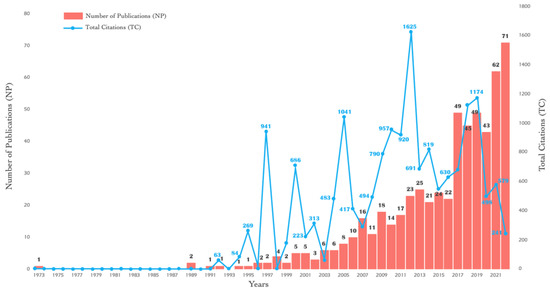
Figure 4.
Dynamics of annual scientific publication and citation rates in compact city studies.
3.1.2. Source Analysis
Analyzing the sources or journals that publish articles related to the compact city concept is a crucial bibliometric analysis method for evaluating scholarly impact and visibility. Table 2 presents the 20 most productive sources based on the number of publications in this field. Notably, the journal Building and Environment emerged as the most productive source, with 21 articles. Other prominent sources included Sustainability (Switzerland), with 18 articles, Cities, with 16 articles, and Sustainable Cities and Society, with 15 articles. These sources demonstrated a consistent contribution to the dissemination of research on compact cities. Other sources, such as Designing High-Density Cities for Social and Environmental Sustainability, International Journal of Environmental Research and Public Health, and Urban Studies, have also made significant contributions with their respective number of publications. The remaining sources in the list have published fewer than 10 articles. The analysis of these sources enables researchers to identify key outlets for their work, provides stakeholders with an overview of influential publications, and contributes to the growth and development of knowledge within the compact city literature. Moreover, the specialization of the journals occupying the list of most productive sources indicates a focused interest in urban and architectural aspects. This highlights the urban dimension of compact cities as a fundamental element and perspective that underpins the other dimensions and perspectives associated with this distinct urban pattern.

Table 2.
Ten most productive sources on compact city literature.
3.1.3. Author Analysis
The analysis of authors in the context of compact city literature is essential for gaining insights into productivity, impact, collaboration patterns, and knowledge development. It addresses three key issues: (a) identifying the most productive and highly cited authors (experts) in the field of compact city literature, (b) examining the publication and citation trends of authors over time, and (c) assessing the extent of collaboration among authors, whether within the compact city domain or involving interdisciplinary collaborations [49,50].
In the realm of compact city literature, a select group of authors emerged as highly prolific contributors based on the number of published articles. Notably, Edward Ng, Chao Ren, Chao Yuan, Jim C.Y., and Kevin Ka-Lun Lau have made substantial contributions, with respective publication counts of 37, 19, 16, 14, and 13. Additionally, when considering the total number of citations received, five authors stand out as experts in compact city research: Edward Ng (TC = 2288), Chao Yuan (TC = 1493), Jim C.Y. (TC = 1116), Chen Liang (TC = 1009), and Burton E. (TC = 832). The presence of overlapping authors in both lists signifies their influential role in shaping the compact city literature. Figure 5, depicting the authors’ productivity over time, reveals a notable surge in scientific output in compact city articles from the early 2000s to the present, with a few notable contributions dating back to the late 1990s, such as Gert de Roo’s study in 1998. These findings provide insights into the influential authors and the evolving landscape of research within the compact city field. Understanding the work of these highly productive authors serves as a benchmark for researchers, offering inspiration and setting standards for rigorous and impactful research. It also aids in identifying reliable and reputable sources of information, as authors with a significant number of publications demonstrate their expertise and the quality of their work. Furthermore, the research directions and trends within the compact city literature are often influenced by these top authors. Studying their publications provides insights into the current research focus, emerging topics, and areas that require further exploration. This knowledge guides future researchers in selecting relevant research topics and avoiding duplication of efforts.
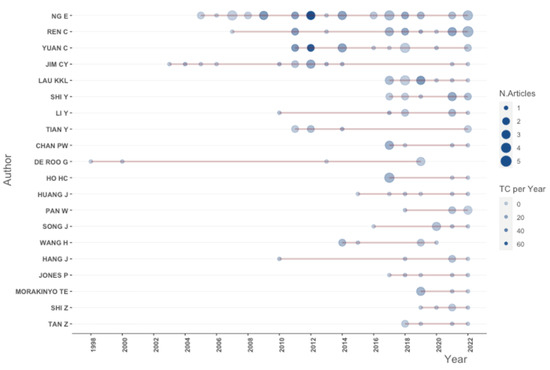
Figure 5.
Chronological representation of the most productive authors in the field of compact city literature. N. Articles: refers to the number of publications; TC per Y: refers to the total citations per year. Red line: refers to the specific period in which the author was actively involved in publishing articles.
The analysis of authors’ collaboration within the compact city literature unveils the collaborative patterns and relationships among researchers in this specific field. The resulting coauthorship network, depicted in Figure 6, reveals the presence of four distinct clusters: red, green, blue, and yellow. Each cluster represents a subset of authors who have collaborated more frequently with each other than with authors from other clusters. Notably, the majority of authors belong to the red cluster, indicating a cohesive and interconnected research community within the compact city literature. It is worth noting that there are instances of collaboration between authors from different clusters, such as Ren C. (red cluster) and Zhang Y. (blue cluster), as well as Song J. (green cluster) and Wang D. (red cluster). This intercluster collaboration highlights the interdisciplinary perspective of compact city literature. These findings allow researchers to identify potential collaborators and build connections within the compact city field. Collaborating with established authors can enhance the quality and impact of research projects, as well as facilitate knowledge exchange and interdisciplinary collaboration.
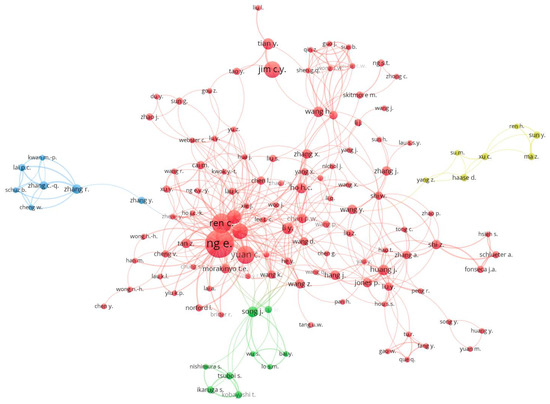
Figure 6.
Coauthorship network in compact city literature. Colors represent clusters, node size indicates total citations (TC), and link strength reflects collaboration.
3.1.4. Documents Analysis
Table 3 showcases the 10 most influential publications in the field of compact city literature, selected based on their significant citation counts. This table provides a comprehensive overview of seminal articles, influential studies, and fundamental works that have played a pivotal role in shaping the understanding and advancement of compact city concepts and research. The article by [1] titled “Are Compact Cities a Desirable Planning Goal?” holds the highest citation count of 737, demonstrating its profound impact. Following closely are the works of [25], [51], and [8], with citation counts of 598, 594, and 547, respectively. It is noteworthy that out of the 10 articles, 8 specifically emphasize the urban dimension of the compact city concept, underscoring its significance within the literature. Recognizing these highly cited publications is essential for the development of the scientific field of compact cities. These top influential publications serve as essential references for researchers and practitioners seeking to delve deeper into the compact city literature. They offer critical insights, theoretical frameworks, empirical evidence, and innovative approaches that have contributed to the development and advancement of knowledge in this field. Researchers can build upon the foundations established by these influential works to explore new avenues of research, address existing gaps, and propose innovative solutions to the challenges faced by compact cities. For example, the most influential publication titled “Are Compact Cities a Desirable Planning Goal?” by [1] holds the highest citation count focused on analyzing the benefits and drawbacks associated with compact cities, addressing topics such as urban density, transportation systems, land use, and environmental considerations. By critically evaluating the arguments and evidence presented in this publication, future researchers can draw upon its insights to explore further aspects of compact city planning, such as social equity, community engagement, and sustainable infrastructure development. Similarly, the works of [8,25,51], also offer substantial contributions to the compact city literature. These publications delved into topics such as mixed land use, walkability, public space design, and the integration of green infrastructure. Future researchers can utilize these influential works as foundational references to investigate emerging issues associated with compact city concepts, such as smart city technologies, resilient urban design, and equitable urban regeneration.

Table 3.
Notable articles in the compact city domain (arranged by TC).
3.1.5. Country (Region) and Institution Analysis
The analysis of countries (regions) and institutions in bibliometric studies holds significant value as it offers insights into the geographic distribution of research output and institutional collaborations and identifies leading contributors in a specific research field. This analysis enables a comprehensive understanding of the global research landscape, facilitates the evaluation of research productivity and impact at national and institutional levels, and uncovers potential collaborative opportunities and emerging research trends [34,50,58].
Examining the country (region) analysis in the context of the compact city literature, Figure 7 showcases the country (region) collaboration network involving 53 countries (regions). Notably, China-Hong Kong emerges as the top contributor, with 106 published articles, followed closely by mainland China, with 90 publications. The United Kingdom secures the third position, with a significant number of publications (n = 37), while the United States, Australia, Japan, and Singapore follow closely, with 36, 33, 32, and 27 published articles, respectively. The prominence of Asian countries (regions) at the top of this list, including China-Hong Kong, mainland China, Japan, Singapore, and South Korea, among others, highlights the global reach and significance of the compact city concept. It further signifies the importance of compact urban environments within the urban systems of these countries (regions).
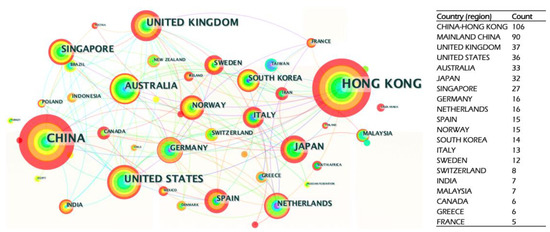
Figure 7.
Country (region) collaboration network in compact city literature. Legend: Node: represents countries (the size of the node represents the country’s scientific production); Link: represents collaborative relations between countries; Colors: represent the temporal orders of co-occurrence links between countries (outside red circle represents nodes with centrality above 0.1/key hub countries).
Moving to the analysis of institutions within the compact city literature, Table 4 presents the most productive institutions based on the number of published articles. The Chinese University of Hong Kong emerges as the most prolific institution, with an impressive count of 110 articles, closely followed by the University of Hong Kong, with 99 articles. The Hong Kong Polytechnic University and National University of Singapore also demonstrate significant presences, with 28 and 25 published articles, respectively. Other notable contributors include the City University of Hong Kong, Sun Yat-Sen University and Tongji University, with 17, 11, and 11 articles, respectively. University of Tsukuba and Hong Kong Observatory also make notable contributions, with 10 and 8 articles, respectively. The dominance of Asia-based institutions in this list reflects their strong dedication to research and scholarly contributions in the field of compact cities. These countries (regions), facing high population densities and limited land resources, recognize the importance of efficient land use and urban planning [59,60]. Moreover, rapid urbanization and growth pose challenges in terms of infrastructure, transportation, and sustainability. As economic powerhouses and global financial centers, these countries (regions) strive to enhance their competitiveness and attract talent [61]. Therefore, their active involvement in compact city research signifies their commitment to addressing these urban challenges and advancing the understanding of sustainable urban development.

Table 4.
The most prolific institutions in the compact city literature.
3.2. Science Mapping
Science mapping, the second level of analysis, aimed to uncover the thematic structure and interconnections within the compact city literature. This was accomplished by analyzing several bibliographic metrics. Firstly, this analysis level encompassed assessing the frequency and burst of keywords to identify prominent themes and emerging trends pertaining to compact city literature, followed by analysis of the references used in the formation of the scientific production on compact cities. Finally, various techniques were employed to delve into the dimensions and themes of the literature, such as thematic map and factorial analysis.
3.2.1. Keyword Analysis
Keyword analysis is widely recognized as a fundamental aspect of bibliometric analysis studies. This analytical unit is crucial in examining the patterns, trends, and relationships within the literature, enabling researchers to gain a comprehensive understanding of the research content [50]. In the context of the compact city concept, Figure 8 presents a word cloud showcasing the prominent keywords in scientific production. The top keywords include urban planning (n = 146), China (n = 97), Hong Kong (n = 95), urban area (n = 90), and sustainable development (n = 75). Other notable keywords, such as compact city, urban development, high-density cities, and land use, also feature in the word cloud. Notably, while “compact city” synonyms do appear, they do not dominate the list, with keywords emphasizing the urban perspective of compact cities taking precedence. This finding suggests a strong emphasis on understanding compact cities from an urban perspective as the core aspect of the concept. Additionally, these domain-specific keywords address the core debates, concepts, and shortcomings in the field of compact city research. For example, the prominence of “China” and “Hong Kong” as keywords may indicate a focus on studying compact cities within the context of rapid urbanization and urban challenges in these regions. Researchers might explore issues such as high-density development, urban governance, and sustainable urban growth within these specific contexts. Additionally, such keywords as smart cities, public transportation, social equity, and green infrastructure shed light on emerging areas of interest and research within the compact city literature.
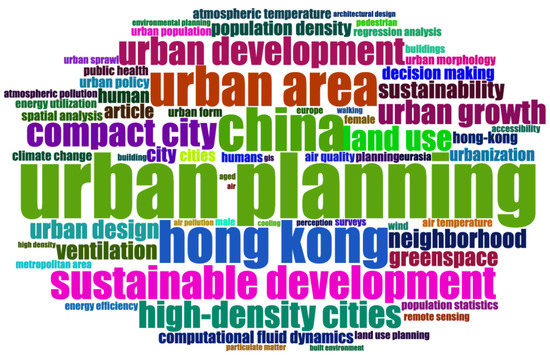
Figure 8.
Word cloud of compact city literature.
Another aspect of investigating and exploring the keywords in specific literature is the keyword burst. Keyword burst refers to a sudden increase in the frequency of a particular keyword compared to its usual occurrence within a specific time period. In the context of the compact city literature, Figure 9 illustrates the occurrence of keyword bursts, highlighting the rapid surge in the frequency of certain keywords [34]. The analysis reveals that keyword bursts in the compact city literature started in 2013 and continued until 2022, with no specific-interest keywords identified prior to that period. Notably, the strongest citation bursts were observed for keywords such as compact city, thermal comfort, sustainable development, and atmospheric temperature. Furthermore, examining the beginning and end of the burst period reveals two distinct phases. From 2013 to 2018, the burst keywords primarily focused on the urban dimension of the compact city concept. However, from 2018 to 2022, the burst keywords shifted towards the environmental dimension of the compact city concept, including keywords such as heat island, thermal comfort, and mental and public health.
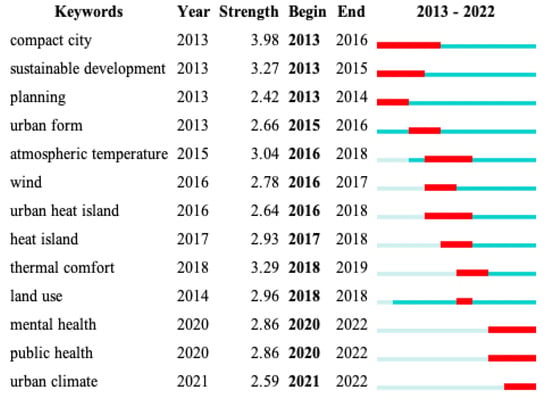
Figure 9.
Top 13 keywords with strongest citation bursts in compact city literature. Legend: Blue line: represents the period of study; Red line: represents the citation burst period.
3.2.2. Reference Analysis
Reference analysis, a bibliometric analysis unit, aims to understand the influential sources and intellectual foundations of the compact city scientific field [50]. To explore the cited references within the compact city literature, the clustered co-citation network is employed. This visualization tool examines the evolution and interconnections of referenced studies over time. Figure 10 illustrates the cluster co-citation references, which groups the documents forming the compact city literature into distinct clusters based on timeline periods. The largest cluster, labelled “High-Density City,” comprises 18 references and exhibits high homogeneity (silhouette value of approximately 0.996). This cluster focuses on spatial issues related to compact cities, including heat, urbanization, wind, and ventilation. The primary cited reference within this cluster is [62], along with other notable references, such as [63,64,65]. The second cluster, labelled “Compact City”, consists of 11 references that support studies discussing the fundamental concept of compact cities. References such as [30,66,67] contribute to this cluster. The third cluster, labelled “Urban Assessment”, comprises nine references, including [68,69], focusing on evaluating the issues associated with compact cities as urban environments. The fourth and final cluster, labelled “Japan”, encompasses seven references, including [70,71,72]. This cluster presents diverse perspectives on the compact city concept, particularly in Asian countries (regions), with a focus on China-Hong Kong and Japan. Analyzing the references related to compact cities is of great importance, as it allows researchers to identify the influential works and intellectual foundations that have shaped the field. By understanding the key references and their interconnections, researchers can trace the evolution of ideas, identify seminal works, and explore the conceptual development of the compact city literature. This analysis provides a solid foundation for future research by highlighting the existing knowledge base and identifying research gaps. For example, by examining the references within the “High-Density City” cluster, researchers can gain insights into the spatial aspects of compact cities, including considerations of urban form, climate, and environmental sustainability. This information can inspire further studies on topics such as urban microclimates, green infrastructure, and sustainable urban design. Another example is found within the “Compact City” cluster, where researchers can explore the foundational literature on the concept of compact cities. By examining the references in this cluster, researchers can delve into the theoretical frameworks, policy implications, and empirical evidence that underpin the concept of compact cities, providing a solid basis for future research and policy development.
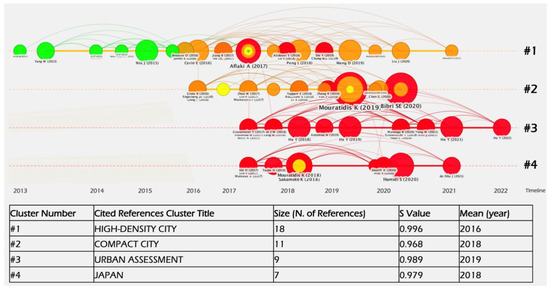
Figure 10.
A timeline view of clustered co-cited references in compact city literature. Legend: S Value (silhouette value): a metric measuring the homogeneity of the created clusters (from 1 to −1, the closer to 1 means higher accuracy and reliability of the cluster). Node: represents reference articles (the size of nodes represents the total citation of the references); Straight Lines: represent the clusters of references based on the clustering algorithm in CiteSpace; Curved lines: the time periods of cited reference articles. Colors: represent the temporal orders of co-occurrence links between references (outside red circle represents nodes with centrality above 0.1/key references).
3.2.3. Literature Dimensions and Themes Analysis
The primary objective of this analysis unit is to uncover the prominent topics, concepts, and research areas within the compact city literature. The unit utilizes two analytical techniques: thematic map and factorial analysis. The thematic map visualizes the relationships among different thematic clusters and categorizes the most cohesive keywords into four quadrants: emerging/declining themes, basic themes, motor themes, and niche themes [73]. Within the emerging/declining quadrant, themes such as ecology, optimization, and carbon are found. These themes have low density and centrality, suggesting that they are either weakly developed or on the periphery of the compact city discourse. For instance, the optimization theme has been extensively explored, and further research may be shifting toward other aspects of compact city development. The ecology and carbon themes, on the other hand, are emerging, indicating a growing recognition of environmental sustainability and ecosystem preservation in the context of compact cities. The basic themes quadrant includes fundamental topics, such as compact city, urban area, sustainability, and spatial analysis, which form the core principles and areas of focus in the study of compact cities. In the motor themes quadrant, topics such as environmental planning, accessibility, and population density are located. These topics are both well developed and important within the compact city literature, representing dynamic and evolving research areas that actively contribute to the advancement of knowledge in the field. Lastly, the niche themes quadrant includes topics with well-developed internal ties but limited external significance. Examples include ventilation, urban morphology, public facilities, and autonomous behavior, indicating researchers’ in-depth exploration of specific areas within these topics. Figure 11 depicts the thematic map of the compact city literature.
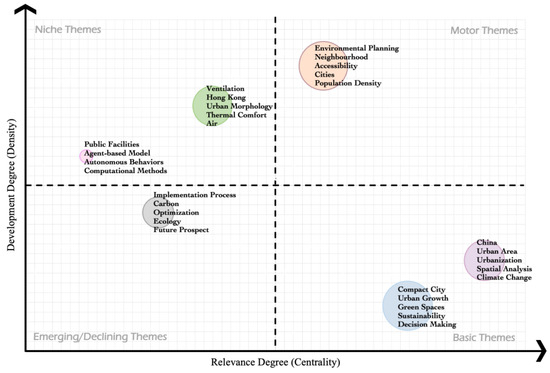
Figure 11.
Thematic map of the compact city literature.
The factorial analysis, depicted in Figure 12, serves as the second analytical technique employed in this literature dimensions and themes analysis. It aims to uncover underlying dimensions or factors that characterize the compact city literature, providing deeper insights into the various research dimensions within this field [74]. The factorial analysis reveals three main clusters: red, blue, and green. The red cluster, the largest, encompasses numerous themes related to compact cities that emphasize the urban perspective and energy and environmental aspects. The blue cluster focuses on the essential components of compact cities, including air quality, buildings, and pedestrian infrastructure. Lastly, the green cluster comprises themes that explore the interaction between residents and the compact city environment, such as human behavior and environmental planning. These clusters shed light on the diverse dimensions and themes within the literature on compact cities.
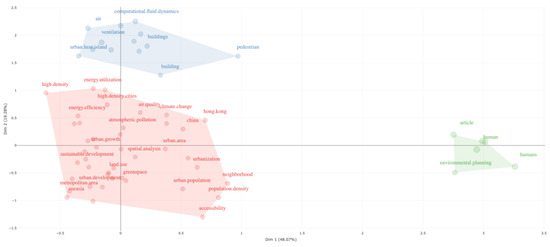
Figure 12.
Factorial analysis of compact city literature.
4. Conclusions and Study Implications
This study significantly contributes to the compact city literature by providing valuable insights, identifying key themes and research trends, and offering practical implications for urban planners, policymakers, and researchers. By conducting a comprehensive bibliometric analysis, this research addresses critical knowledge gaps in the field and lays the foundation for further exploration and interdisciplinary collaborations. The insights gained from this study have important implications for policy and practice in compact city planning and development. Decision-makers can rely on the findings to guide their decision-making processes, inform policy formulation, and support the implementation of evidence-based practices. The identified influential publications, key authors, and research trends serve as valuable resources to inform and shape effective strategies in creating sustainable, livable, and resilient compact cities.
Urban planners and practitioners can also benefit from this study’s implications. The identified themes and research trends provide a broader understanding of the current discourse in compact city literature, helping professionals stay up to date with the latest developments in the field. This knowledge can guide their planning processes, facilitate innovative design approaches, and support the integration of sustainable practices in compact city development. Furthermore, the study’s contribution to interdisciplinary collaborations is noteworthy. By highlighting the interdisciplinary nature of compact city research, this study encourages researchers from various disciplines, such as urban planning, architecture, environmental science, and social sciences, to collaborate and combine their expertise. This interdisciplinary collaboration can lead to holistic and innovative solutions for the complex challenges faced by compact cities, fostering sustainable and inclusive urban development.
In conclusion, this study’s implications extend beyond academic discourse and have practical significance for urban planners, policymakers, and researchers in the field of compact cities. The insights and knowledge generated can guide decision-making processes, inform policy formulation, support evidence-based practices, and foster interdisciplinary collaborations. By leveraging the influential publications identified, key authors, and research trends, stakeholders can work together towards creating sustainable, livable, and resilient compact cities.
The objective of this study was to conduct a comprehensive bibliometric analysis of the compact city literature, aiming to explore, analyze, and investigate its scientific production. The study employed various bibliometric analysis units, including scientific production analysis, author analysis, document analysis, source analysis, country (region) and institution analysis, reference analysis, keyword analysis, and dimension and theme analysis. These bibliometric analytical units were categorized into two main levels: performance analysis and science mapping. The findings of this extensive analysis revealed several key insights into the compact city literature.
Firstly, it was observed that scientific production in the field of compact cities has experienced significant growth in recent years, indicating a growing interest in exploring the various dimensions of these unique urban environments. The literature has also witnessed a shift in focus from basic concepts to more specific issues, such as the spatial challenges faced by high-density cities and the evaluation of compact city environments. Moreover, emerging interests in environmental sustainability and ecosystem preservation were identified, highlighting the increasing recognition of the importance of sustainable practices within the compact city discourse.
In terms of authorship, certain individuals emerged as experts in the field of compact cities based on their substantial contributions to the literature. Notable authors, such as Edward Ng, Chao Ren, Chao Yuan, Jim C.Y., and Kevin Ka-Lun Lau, were identified as influential figures whose works are crucial for researchers seeking to gain a comprehensive understanding of the compact city concept.
The geographic distribution of the compact city literature revealed interesting patterns, with Asian countries (regions), particularly China-Hong Kong and mainland China, playing a prominent role in scientific production. This finding was supported by various bibliometric analysis units, such as country (region) and institution analysis. The dominance of mainland China and China-Hong Kong in the compact city literature can be attributed to the challenges these countries (regions) face due to resource scarcity and high population growth, making compact cities essential for optimizing land utilization and mitigating urban sprawl. Compact cities in these regions have emerged as vital contributors to economic growth, serving as hubs for innovation, commerce, and finance.
Keyword analysis highlighted the multidimensional nature of the compact city concept. While there are various dimensions and perspectives explored in the literature, the urban perspective was identified as a fundamental starting point for understanding compact cities. Therefore, future research endeavors should prioritize a comprehensive understanding of the urban environment as a key element for exploring other aspects and proposing effective solutions to the studied issues.
It is also important to acknowledge certain limitations of this bibliometric analysis. These include the reliance on selected databases, the focus on a specific time period, potential language biases associated with focusing on specific languages (e.g., English), and potential citation practices that may introduce biases. Despite these limitations, the studies presented justifications for these limitations, as well as presenting rigorous analysis and valuable insights, offering significant contributions to the understanding of the compact city literature.
Supplementary Materials
The following supporting information can be downloaded at: https://www.mdpi.com/article/10.3390/su151310302/s1. PRISMA 2020 Checklist. Reference [75] is cited in Supplementary Materials.
Funding
This research received no external funding.
Data Availability Statement
Data are contained within the article.
Acknowledgments
The author would like to gratefully thank the Deanship of Scientific Research and Researchers Support and Services Unit at King Saud University.
Conflicts of Interest
The author declares no conflict of interest.
References
- Gordon, P.; Richardson, H.W. Are Compact Cities a Desirable Planning Goal? J. Am. Plan. Assoc. 1997, 63, 95–106. [Google Scholar] [CrossRef]
- Haarstad, H.; Kjærås, K.; Røe, P.G.; Tveiten, K. Grounding the Compact City. Dialogues Hum. Geogr. 2023, 13, 50–53. [Google Scholar] [CrossRef]
- O’Toole, R. The Myth of the Compact City: Why Compact Development Is Not the Way to Reduce Carbon Dioxide Emissions. SSRN J. 2009, 653, 1–23. [Google Scholar] [CrossRef]
- Jacobs, J. The Death and Life of Great American Cities; Modern Library: New York, NY, USA, 1969. [Google Scholar]
- Dantzig, G.B.; Saaty, T.L. Compact City: A Plan for a Liveable Urban Environment; W.H. Freeman: New York, NY, USA, 1973; ISBN 978-0-7167-0794-3. [Google Scholar]
- Kain, J.-H.; Stenberg, J.; Adelfio, M.; Oloko, M.; Thuvander, L.; Zapata, P.; Zapata Campos, M.J. What Makes a Compact City? Differences Between Urban Research in the Global North and the Global South. SJPA 2020, 24, 25–49. [Google Scholar] [CrossRef]
- Tan, P.Y.; Rinaldi, B.M. Landscapes for Compact Cities. J. Landsc. Archit. 2019, 14, 4–7. [Google Scholar] [CrossRef]
- Burton, E. The Compact City: Just or Just Compact? A Preliminary Analysis. Urban Stud. 2000, 37, 1969–2006. [Google Scholar] [CrossRef]
- Newman, P.G.; Kenworthy, J.R. Cities and Automobile Dependence: An International Sourcebook; Gower Publishing: Brookfield, VT, USA, 1989; ISBN 0-566-07040-5. [Google Scholar]
- Elkin, T.; McLaren, D.; Hillman, M. Friends of the Earth with Policy Studies Institute. Reviving the City: Towards Sustainable Urban Development; Friends of the Earth with Policy Studies Institute: Washington, DC, USA, 1991; ISBN 978-0-905966-83-0. [Google Scholar]
- Breheny, M.J. Sustainable Development and Urban Form; Pion: Eindhoven, The Netherlands, 1992; ISBN 978-0-85086-160-0. [Google Scholar]
- Daneshpour, A.; Shakibamanesh, A. Compact City; Dose It Create an Obligatory Context for Urban Sustainability? Urban Plan. 2011, 21, 110–118. [Google Scholar]
- Kotulla, T.; Denstadli, J.M.; Oust, A.; Beusker, E. What Does It Take to Make the Compact City Liveable for Wider Groups? Identifying Key Neighbourhood and Dwelling Features. Sustainability 2019, 11, 3480. [Google Scholar] [CrossRef]
- Shi, L.; Yang, S.; Gao, L. Effects of a Compact City on Urban Resources and Environment. J. Urban Plann. Dev. 2016, 142, 05016002. [Google Scholar] [CrossRef]
- Bhagwat, J.M.; Devadas, V. Planning for a sustainable compact city: A way forward. WIT Trans. Ecol. Environ. 2020, 241, 113–122. [Google Scholar]
- Monkkonen, P.; Montejano, J.; Guerra, E.; Caudillo, C. Compact Cities and Economic Productivity in Mexico. Urban Stud. 2020, 57, 2080–2097. [Google Scholar] [CrossRef]
- Fan, T.; Chapman, A. Policy Driven Compact Cities: Toward Clarifying the Effect of Compact Cities on Carbon Emissions. Sustainability 2022, 14, 12634. [Google Scholar] [CrossRef]
- Westerink, J.; Haase, D.; Bauer, A.; Ravetz, J.; Jarrige, F.; Aalbers, C.B.E.M. Dealing with Sustainability Trade-Offs of the Compact City in Peri-Urban Planning Across European City Regions. Eur. Plan. Stud. 2013, 21, 473–497. [Google Scholar] [CrossRef]
- Bafarasat, A.Z. Invisible Travels in the Compact City: Is Density the Way Forward? J. Urban Plann. Dev. 2017, 143, 05017008. [Google Scholar] [CrossRef]
- Washino, S. The Compact City Approach: Environment, Safety and Electric Vehicles. IATSS Res. 2008, 32, 54–59. [Google Scholar] [CrossRef]
- Yin, C.; Sun, B. Does Compact Built Environment Help to Reduce Obesity? Influence of Population Density on Waist–Hip Ratio in Chinese Cities. Int. J. Environ. Res. Public Health 2020, 17, 7746. [Google Scholar] [CrossRef] [PubMed]
- Ihlebæk, C.; Næss, P.; Stefansdottir, H. Are Compact Cities a Threat to Public Health? Eur. Plan. Stud. 2021, 29, 1021–1049. [Google Scholar] [CrossRef]
- Kim, D.H.; Yoo, S. How Does the Built Environment in Compact Metropolitan Cities Affect Health? A Systematic Review of Korean Studies. Int. J. Environ. Res. Public Health 2019, 16, 2921. [Google Scholar] [CrossRef]
- Limb, M.; Grodach, C.; Mayere, S.; Donehue, P. Rethinking the Implementation of the Compact City: Factors Affecting Compact Activity Centre Policy Conformance in Greater Brisbane, 1996 to 2016. Urban Policy Res. 2020, 38, 291–306. [Google Scholar] [CrossRef]
- Neuman, M. The Compact City Fallacy. J. Plan. Educ. Res. 2005, 25, 11–26. [Google Scholar] [CrossRef]
- Gill, K.; Van Hellemondt, I.; Larsen, J.K.; Keravel, S.; Leger-Smith, A.; Notteboom, B.; Rinaldi, B.M. Corona, the Compact City and Crises. J. Landsc. Archit. 2020, 15, 4–5. [Google Scholar] [CrossRef]
- Mouratidis, K. COVID-19 and the Compact City: Implications for Well-Being and Sustainable Urban Planning. Sci. Total Environ. 2022, 811, 152332. [Google Scholar] [CrossRef]
- Zhang, X.; Sun, Z.; Ashcroft, T.; Dozier, M.; Ostrishko, K.; Krishan, P.; McSwiggan, E.; Keller, M.; Douglas, M. Compact Cities and the COVID-19 Pandemic: Systematic Review of the Associations between Transmission of COVID-19 or Other Respiratory Viruses and Population Density or Other Features of Neighbourhood Design. Health Place 2022, 76, 102827. [Google Scholar] [CrossRef] [PubMed]
- Lim, H.K.; Kain, J.-H. Compact Cities Are Complex, Intense and Diverse but: Can We Design Such Emergent Urban Properties? Urban Plan. 2016, 1, 95–113. [Google Scholar] [CrossRef]
- Bibri, S.E.; Krogstie, J.; Kärrholm, M. Compact City Planning and Development: Emerging Practices and Strategies for Achieving the Goals of Sustainability. Dev. Built Environ. 2020, 4, 100021. [Google Scholar] [CrossRef]
- Conticelli, E. Compact city as a model achieving sustainable development. In Sustainable Cities and Communities; Leal Filho, W., Azul, A.M., Brandli, L., Özuyar, P.G., Wall, T., Eds.; Springer International Publishing: Cham, Switzerland, 2019; pp. 1–10. ISBN 978-3-319-71061-7. [Google Scholar]
- Page, M.J.; Moher, D.; Bossuyt, P.M.; Boutron, I.; Hoffmann, T.C.; Mulrow, C.D.; Shamseer, L.; Tetzlaff, J.M.; Akl, E.A.; Brennan, S.E.; et al. PRISMA 2020 Explanation and Elaboration: Updated Guidance and Exemplars for Reporting Systematic Reviews. BMJ 2021, 372, n160. [Google Scholar] [CrossRef] [PubMed]
- Page, M.J.; McKenzie, J.E.; Bossuyt, P.M.; Boutron, I.; Hoffmann, T.C.; Mulrow, C.D.; Shamseer, L.; Tetzlaff, J.M.; Akl, E.A.; Brennan, S.E.; et al. The PRISMA 2020 Statement: An Updated Guideline for Reporting Systematic Reviews. Syst. Rev. 2021, 10, 89. [Google Scholar] [CrossRef]
- Kabil, M.; Priatmoko, S.; Magda, R.; Dávid, L.D. Blue Economy and Coastal Tourism: A Comprehensive Visualization Bibliometric Analysis. Sustainability 2021, 13, 3650. [Google Scholar] [CrossRef]
- Osareh, F. Bibliometrics, Citation Analysis and Co-Citation Analysis: A Review of Literature I. Libri 1996, 46, 54127881. [Google Scholar] [CrossRef]
- Donthu, N.; Kumar, S.; Mukherjee, D.; Pandey, N.; Lim, W.M. How to Conduct a Bibliometric Analysis: An Overview and Guidelines. J. Bus. Res. 2021, 133, 285–296. [Google Scholar] [CrossRef]
- Salisbury, L. Web of Science and Scopus: A Comparative Review of Content and Searching Capabilities. Charlest. Advis. 2009, 11, 5–18. [Google Scholar]
- Archambault, É.; Gagné, É.V. The Use of Bibliometrics in the Social Sciences and Humanities; Social Sciences and Humanities Research Council of Canada (SSHRCC): Ottawa, ON, Canada, 2004; p. 79. [Google Scholar]
- Persson, O.; Danell, R.; Schneider, J.W. How to Use Bibexcel for Various Types of Bibliometric Analysis; Lund University: Lund, Sweden, 2009. [Google Scholar]
- Sci2 Team Science of Science (Sci2) Tool. Available online: https://sci2.cns.iu.edu (accessed on 5 April 2023).
- Mrvar, A.; Batagelj, V. Analysis and Visualization of Large Networks with Program Package Pajek. Complex Adapt. Syst. Model 2016, 4, 6. [Google Scholar] [CrossRef]
- Garfield, E.; Paris, S.W.; Stock, W.G. HistCiteTM: A Software Tool for Informetric Analysis of Citation Linkage. Inf. Wiss. Und Prax. 2006, 57, 391. [Google Scholar]
- Cobo, M.J.; López-Herrera, A.G.; Herrera-Viedma, E.; Herrera, F. SciMAT: A New Science Mapping Analysis Software Tool. J Am. Soc. Inf. ScTec/ 2012, 63, 1609–1630. [Google Scholar] [CrossRef]
- Bastian, M.; Heymann, S.; Jacomy, M. Gephi: An Open Source Software for Exploring and Manipulating Networks. ICWSM 2009, 3, 361–362. [Google Scholar] [CrossRef]
- van Eck, N.J.; Waltman, L. CitNetExplorer: A New Software Tool for Analyzing and Visualizing Citation Networks. J. Informetr. 2014, 8, 802–823. [Google Scholar] [CrossRef]
- van Eck, N.J.; Waltman, L. Software Survey: VOSviewer, a Computer Program for Bibliometric Mapping. Scientometrics 2010, 84, 523–538. [Google Scholar] [CrossRef] [PubMed]
- Chaomei Chen CiteSpace. Available online: https://citespace.podia.com/ (accessed on 12 December 2022).
- Aria, M.; Cuccurullo, C. Bibliometrix: An R-Tool for Comprehensive Science Mapping Analysis. J. Informetr. 2017, 11, 959–975. [Google Scholar] [CrossRef]
- Kabil, M.; Ali, M.A.; Marzouk, A.; Dávid, L.D. Gender Perspectives in Tourism Studies: A Comparative Bibliometric Analysis in the MENA Region. Tour. Plan. Dev. 2022, 1–23. [Google Scholar] [CrossRef]
- Zupic, I.; Čater, T. Bibliometric Methods in Management and Organization. Organ. Res. Methods 2015, 18, 429–472. [Google Scholar] [CrossRef]
- Ng, E.; Chen, L.; Wang, Y.; Yuan, C. A Study on the Cooling Effects of Greening in a High-Density City: An Experience from Hong Kong. Build. Environ. 2012, 47, 256–271. [Google Scholar] [CrossRef]
- Ng, E. Policies and Technical Guidelines for Urban Planning of High-Density Cities—Air Ventilation Assessment (AVA) of Hong Kong. Build. Environ. 2009, 44, 1478–1488. [Google Scholar] [CrossRef] [PubMed]
- Holden, E.; Norland, I.T. Three Challenges for the Compact City as a Sustainable Urban Form: Household Consumption of Energy and Transport in Eight Residential Areas in the Greater Oslo Region. Urban Stud. 2005, 42, 2145–2166. [Google Scholar] [CrossRef]
- Ng, E.; Yuan, C.; Chen, L.; Ren, C.; Fung, J.C.H. Improving the Wind Environment in High-Density Cities by Understanding Urban Morphology and Surface Roughness: A Study in Hong Kong. Landsc. Urban Plan. 2011, 101, 59–74. [Google Scholar] [CrossRef]
- Stone, B.; Hess, J.J.; Frumkin, H. Urban Form and Extreme Heat Events: Are Sprawling Cities More Vulnerable to Climate Change Than Compact Cities? Environ. Health Perspect 2010, 118, 1425–1428. [Google Scholar] [CrossRef] [PubMed]
- Chen, H.; Jia, B.; Lau, S.S.Y. Sustainable Urban Form for Chinese Compact Cities: Challenges of a Rapid Urbanized Economy. Habitat Int. 2008, 32, 28–40. [Google Scholar] [CrossRef]
- Stevenson, M.; Thompson, J.; De Sá, T.H.; Ewing, R.; Mohan, D.; McClure, R.; Roberts, I.; Tiwari, G.; Giles-Corti, B.; Sun, X.; et al. Land Use, Transport, and Population Health: Estimating the Health Benefits of Compact Cities. Lancet 2016, 388, 2925–2935. [Google Scholar] [CrossRef]
- Kabil, M.; Abouelseoud, M.; Alsubaie, F.; Hassan, H.M.; Varga, I.; Csobán, K.; Dávid, L.D. Evolutionary Relationship between Tourism and Real Estate: Evidence and Research Trends. Sustainability 2022, 14, 10177. [Google Scholar] [CrossRef]
- Su, H.; Wei, H.; Zhao, J. Density Effect and Optimum Density of the Urban Population in China. Urban Stud. 2017, 54, 1760–1777. [Google Scholar] [CrossRef]
- Wang, Y.; Shaw, D. The Complexity of High-Density Neighbourhood Development in China: Intensification, Deregulation and Social Sustainability Challenges. Sustain. Cities Soc. 2018, 43, 578–586. [Google Scholar] [CrossRef]
- Chen, Y.; Ju, G. Fight, Flight or Friction? The Effect of Population Density on General Trust in China. Chin. Sociol. Rev. 2023, 1–32. [Google Scholar] [CrossRef]
- Hua, J.; Zhang, X.; Ren, C.; Shi, Y.; Lee, T.-C. Spatiotemporal Assessment of Extreme Heat Risk for High-Density Cities: A Case Study of Hong Kong from 2006 to 2016. Sustain. Cities Soc. 2021, 64, 102507. [Google Scholar] [CrossRef]
- Aflaki, A.; Mirnezhad, M.; Ghaffarianhoseini, A.; Ghaffarianhoseini, A.; Omrany, H.; Wang, Z.-H.; Akbari, H. Urban Heat Island Mitigation Strategies: A State-of-the-Art Review on Kuala Lumpur, Singapore and Hong Kong. Cities 2017, 62, 131–145. [Google Scholar] [CrossRef]
- Peng, L.; Liu, J.-P.; Wang, Y.; Chan, P.; Lee, T.; Peng, F.; Wong, M.; Li, Y. Wind Weakening in a Dense High-Rise City Due to over Nearly Five Decades of Urbanization. Build. Environ. 2018, 138, 207–220. [Google Scholar] [CrossRef]
- Wang, D.; Lau, K.K.-L.; Ren, C.; Goggins, W.B.I.; Shi, Y.; Ho, H.C.; Lee, T.-C.; Lee, L.-S.; Woo, J.; Ng, E. The Impact of Extremely Hot Weather Events on All-Cause Mortality in a Highly Urbanized and Densely Populated Subtropical City: A 10-Year Time-Series Study (2006–2015). Sci. Total Environ. 2019, 690, 923–931. [Google Scholar] [CrossRef]
- Li, X.; Ratti, C.; Seiferling, I. Quantifying the Shade Provision of Street Trees in Urban Landscape: A Case Study in Boston, USA, Using Google Street View. Landsc. Urban Plan. 2018, 169, 81–91. [Google Scholar] [CrossRef]
- Mouratidis, K. Compact City, Urban Sprawl, and Subjective Well-Being. Cities 2019, 92, 261–272. [Google Scholar] [CrossRef]
- He, Y.; Tablada, A.; Wong, N.H. Effects of Non-Uniform and Orthogonal Breezeway Networks on Pedestrian Ventilation in Singapore’s High-Density Urban Environments. Urban Clim. 2018, 24, 460–484. [Google Scholar] [CrossRef]
- He, Y.; Tablada, A.; Wong, N.H. A Parametric Study of Angular Road Patterns on Pedestrian Ventilation in High-Density Urban Areas. Build. Environ. 2019, 151, 251–267. [Google Scholar] [CrossRef]
- Hamidi, S.; Sabouri, S.; Ewing, R. Does Density Aggravate the COVID-19 Pandemic?: Early Findings and Lessons for Planners. J. Am. Plan. Assoc. 2020, 86, 495–509. [Google Scholar] [CrossRef]
- Mouratidis, K. Is Compact City Livable? The Impact of Compact versus Sprawled Neighbourhoods on Neighbourhood Satisfaction. Urban Stud. 2018, 55, 2408–2430. [Google Scholar] [CrossRef]
- Sakamoto, K.; Iida, A.; Yokohari, M. Spatial Patterns of Population Turnover in a Japanese Regional City for Urban Regeneration against Population Decline: Is Compact City Policy Effective? Cities 2018, 81, 230–241. [Google Scholar] [CrossRef]
- Khare, A.; Jain, R. Mapping the Conceptual and Intellectual Structure of the Consumer Vulnerability Field: A Bibliometric Analysis. J. Bus. Res. 2022, 150, 567–584. [Google Scholar] [CrossRef]
- Valderrama, P.; Jiménez-Contreras, E.; Escabias, M.; Valderrama, M.J. Introducing a Bibliometric Index Based on Factor Analysis. Scientometrics 2022, 127, 509–522. [Google Scholar] [CrossRef]
- Page, M.J.; McKenzie, J.E.; Bossuyt, P.M.; Boutron, I.; Hoffmann, T.C.; Mulrow, C.D.; Shamseer, L.; Tetzlaff, J.M.; Akl, E.A.; Brennan, S.E.; et al. The PRISMA 2020 Statement: An Updated Guideline for Reporting Systematic Reviews. BMJ 2021, 372, n71. [Google Scholar] [CrossRef]
Disclaimer/Publisher’s Note: The statements, opinions and data contained in all publications are solely those of the individual author(s) and contributor(s) and not of MDPI and/or the editor(s). MDPI and/or the editor(s) disclaim responsibility for any injury to people or property resulting from any ideas, methods, instructions or products referred to in the content. |
© 2023 by the author. Licensee MDPI, Basel, Switzerland. This article is an open access article distributed under the terms and conditions of the Creative Commons Attribution (CC BY) license (https://creativecommons.org/licenses/by/4.0/).








